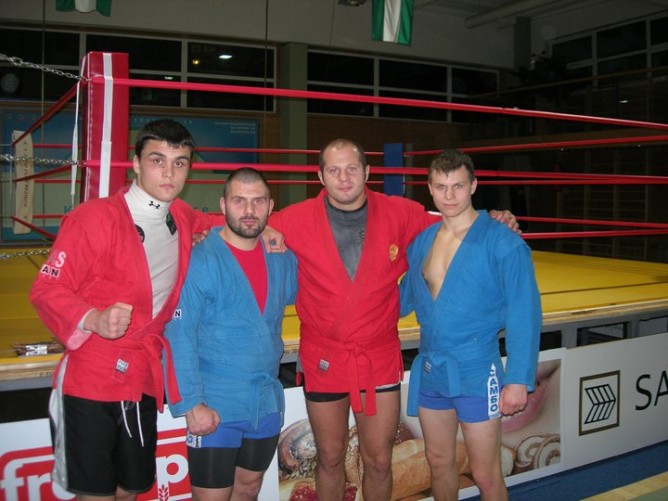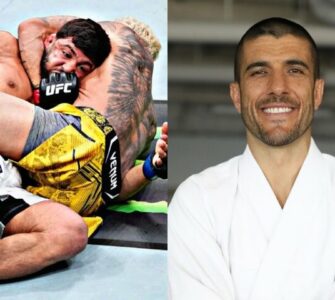Sambo is a Russian martial art and combat sport. The word “SAMBO” is an acronym for SAMozashchita Bez Oruzhiya, which literally translates as “self-defense without weapons”. Sambo is relatively modern since its development began in the early 1920s by the Soviet Red Army to improve their hand-to-hand combat abilities. Intended to be a merger of the most effective techniques of other martial arts, Sambo has roots in Japanese Judo, international styles of wrestling, plus traditional folk styles of wrestling such as: Armenian Kokh, Georgian Chidaoba, Romanian Trîntǎ, Tatar Köräş, Uzbek Kurash, Mongolian Khapsagay and Azerbaijani Gulesh.
There are 2 recognized competitive sport variations of Sambo:
-Sport Sambo (Russian: Борьбa Самбо, Bor’ba Sambo, Sambo Wrestling (eng)) is stylistically similar to Olympic Freestyle Wrestling or Judo, but with some differences in rules, protocol, and uniform. For example, in contrast with judo, Sambo allows some types of leg locks, while not allowing chokeholds. It focuses on throwing, ground work and submissions, with (compared to Judo) very few restrictions on gripping and holds.
-Combat Sambo (Russian: Боевое Самбо, Boyevoye Sambo). Utilized and developed for the military, Combat Sambo resembles modern mixed martial arts, including extensive forms of striking and grappling where (unlike Sport Sambo) choking and bent joint locks are legal. Competitors wear jackets as in sport sambo, but also hand protection and sometimes shin and head protection. The first FIAS World Combat Sambo Championships were held in 2001.
In an in depth interview with Bloodyelbow, Sambo Master Vadim Kolganov, was asked by Iain Kidd, to explain the success of Sambo fighters in MMA (Fedor, Sergey Kharitonov, Khabib Nuramgomedov etc..).

He also explained the main differences and similarities between Sambo and BJJ:
Iain Kidd: When we see people come over from Judo to MMA, they sometimes struggle with the lack of a jacket. What is it about Sambo that makes the transition easier from jacket to no jacket?
Vadim Kolganov: I think it’s probably that most Sambists cross-train. The adaptability of Sambo makes it easy to transfer from one thing to another because it’s so flexible. Judo is great, I really do like it, but there are a lot of restrictions, especially nowadays. If you change the grip from the classic sleeve and lapel grip, they complain, ‘that’s not Judo, that’s wrestling,’ but Judo was wrestling the last time I checked! It seems like Judo practitioners want to keep Judo pure, but along the way they lost the point a little bit.
So they do well on the Judo circuit, but when the rules change, they can find it difficult to adapt. Sambo is more flexible, especially with the grips. My favorite is two-on-one grip, but Judo guys hate that, because it’s not ‘normal’. They get panicky and don’t know how to deal with it. In Sambo, there are lots of different grips and wrestling applications, so it’s easy to transition.
Part of Sambo was catch-as-catch-can wrestling, which is where Sambo takes its leglocks from… Sambo improves it though. Because it’s Russian, it’s better [Laughs].
Iain Kidd: A lot of techniques we see on the ground in Sambo are very similar to what we see in BJJ. Obviously both have some roots in old-style Judo, but how much of Sambo is based on submission grappling specifically?
Vadim Kolganov: Hmm… bear with me while I try to answer that question. When somebody says, ‘Oh we have that technique in Tae-Kwon-Do,’ or, ‘That’s a Judo technique,’ to me a human body is a human body. We’re not aliens with six hands. The body works only in a certain way. It’s just about application of knowledge of the human anatomy.
In Russia there are a lot of sports universities that will teach not just the practical and technical aspect of Sambo, but also the psychological side, body mechanics and biochemistry, so you get really good specialists in the field. You’re really taught the science of sport, and when that’s put together Sambo is kind of the result.
Iain Kidd: In Brazilian Jiu-Jitsu grappling, there aren’t any strikes. As a result we sometimes see black belts come into the cage and their technique suffers when they start taking punches to the face. That doesn’t seem to happen with Sambists, is that something trained for in Sambo?
Vadim Kolganov: There are some old Sambists who only like grappling, but Sambo, from the start, was an evolving sport. The good thing about Sambo is it has never lost that essence; it uses techniques that work, and doesn’t use techniques that don’t. It’s natural selection again, if a technique doesn’t work, we don’t use it anymore.
With Judo practitioners now, their stand up throws are great, but the ground work is awful. My students went into training with some Judo guys and a guy with a black belt said to one of my students, ‘Hey, Sambo guy, watch out for our chokes!’ My student, who is a novice, choked him out in about 20 seconds.
In BJJ, the ground work is awesome. There are so many transitions that sometimes I actually find it too complicated. I like simple things, because simple things work. You know that KISS principle? Keep It Simple Stupid? Yeah, I like that, because the more complex something is, the more space for error there is.
Sambo has got both. It has good stand up, and good ground work. To me, it’s also more simple, and that’s why it works. Well… not simple, but less complex. The correct term to use might be that Sambo is more direct.

















